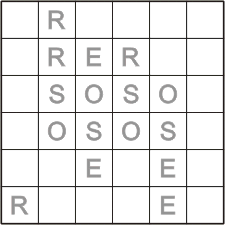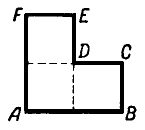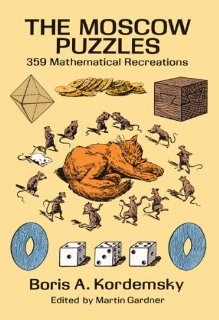Boris A. Kordemsky and Martin Gardener (ed.) and Albert Parry (tr) and YevgenThe Moscow Puzzles: 359 Mathematical Recreations
i Konstantinovich Argutinsky (ill)
Kordemsky, Boris A.; Martin Gardener (ed.); Albert Parry (tr); Yevgeni Konstantinovich Argutinsky (ill);
The Moscow Puzzles: 359 Mathematical Recreations
Courier Dover (Math & Logic Puzzles), 1992, 309 pages
ISBN 0486270785, 9780486270784
topics: | math | puzzle |
Kordemsky's Matematicheskaya Smekalka (1954) is probably the world's best-selling book of mathematical puzzles, with more than a million copies sold in the Soviet Union, and many more in translation. It was late in being translated into English (1972), and the translation replaces Kordemsky's original introduction with a short note from Gardener.
The puzzles are simple, and illustrations work well. However, the text is sometimes a bit cryptic - e.g. see my comment below puzzle 3.
Like most compilations, many puzzles are from other sources, but a significant fraction is original. The puzzles vary in their level of challenge (as the sampling below shows).
Kordemsky playing with 3-D puzzles. photo by Anatoly Kalinin, from ageofpuzzles.com About the title - why 359? It's a prime. But the original text by Kordemsky had more puzzles - especially on number theory. Gardener pruned these since he felt these would require more specialized knowledge.
Excerpts
from Intro by Martin Gardener
This is the first English translation of Mathematical Know-how, the best and most popular puzzle book ever published in the Soviet Union. Since its first appearance in 1956 there have been eight editions, as well as translations from the original Russian into Ukrainian, Estonian, Lettish, and Lithuanian. Almost a million copies of the Russian version alone have been sold. Outside the U.S.S.R. the book has been published in Bulgaria, Rumania, Hungary, Czechoslovakia, Poland, Germany, France, China, Japan, and Korea. The author, Boris A. Kordemsky, who was born in 1907 [d.1999], is a talented high school mathematics teacher in Moscow. His first book on recreational mathematics, The Wonderful Square, a delightful discussion of curious properties of the ordinary geometric square, was published in Russian in 1952. In 1958 his Essays on Challenging Mathematical Problems appeared. In collaboration with an engineer he produced a picture book for children, Geometry Aids Arithmetic (1960), which by lavish use of color overlays, shows how simple diagrams and graphs can be used in solving arithmetic problems. His Foundations of the Theory of Probabilities appeared in 1964, and in 1967 he collaborated on a textbook about vector algebra and analytic geometry. But it is for his mammoth puzzle collection that Kordemsky is best known in the Soviet Union, and rightly so, for it is a marvelously varied assortment of brain teasers.
from biography by Will Shortz and Serhiy Grabarchuk
http://www.ageofpuzzles.com/Masters/BorisKordemsky/BorisKordemsky.htm Boris Kordemsky (1907-1999), a Russian teacher and popularizer of recreational mathematics, is probably the best-selling author of nonword puzzle books in the history of the world. Just one of his books, Matematicheskaya Smekalka (or, Mathematical Quick-Wits), sold more than a million copies in the Soviet Union/Russia alone, and it has been translated into many languages. By exciting millions of people in mathematical problems over five decades, he influenced generations of solvers both at home and abroad. Knowledgable solvers recognized some of the puzzles as the original inventions of the American Sam Loyd, the British Henry E. Dudeney, the Belgian Maurice Kraitchik, and others. But undoubtedly a significant number of the puzzles were new. [this page also has four puzzles]
Puzzles
3. Moving Checkers
Place 6 checkers on a table in a row, alternating them black, white, black, white, and so on, as shown. [e=empty; B=black, W=white] . . . . B W B W B W Leave a vacant place large enough for 4 checkers on the left. Move the checkers so that all the white ones will end on the left, followed by all the black ones. The checkers must be moved in pairs, taking 2 adjacent checkers at a time, without disturbing their order, and sliding them to a vacant place. To solve this problem, only three such moves are necessary. [The phrase "slide them to a vacant place" gives the impression (to me) that one should slide it along the line. A little observation however shows that this cannot result in a solution. ]
4. Three Matchstick piles
Place three piles of matches on a table, one with 11 matches, the second with 7, and the third with 6. You are to move matches so that each pile holds 8 matches. You may add to any pile only as many matches as it already contains, and all the matches must come from one other pile. For example, if a pile holds 6 matches, you may add 6 to it, no more or less. You have three moves.
42. Tell "at a glance"
Here are two columns of numbers: 123456789 1 12345678 21 1234567 321 123456 4321 12345 54321 1234 654321 123 7654321 12 87654321 1 987654321 Look closely: the numbers on the right are the same as on the left, but reversed and in reverse order. Which column has the larger total? (First answer "at a glance"; then check by adding.)
50. How Many Routes?
"In our Mathematics Circle we diagramed 16 blocks of our city. How many different routes can we draw from A to C moving only upward and to the right?Different routes may, of course, have portions that coincide (as in the diagram).
II. Difficult Problems
88. Cat and mice
A cat is taking a nap. He dreams he is encircled by 13 mice: 12 gray and 1 white. He hears his owner saying: "Cat: you are to eat each thirteenth mouse, keeping the same direction. The last mouse you eat must be the white one." Which mouse should he start from?
110. Knight's move
There are 16 pawns on a chessboard. Can a knight capture all 16 pawns in 16 moves? . . . . . . . . . . . . p p p . . . . . p . p . . . . . p p p . . p p p . . . . . p . p . . . . . p p p . . . . . . . . . . . .
147. Roses puzzle
(This version is a reconstruction of Kordemsky's problem 147, by Will Shortz and Serhiy Grabarchuk] Divide the square grid into four equal (and congruent) parts so that each part contains exactly one each of the letters R, O, S, and E.
153. A Dissection Puzzle
Cut ABCDEF into 2 parts that can be fitted together as a square frame. The opening in the frame should be a square congruent to each of the 3 squares composing the original figure.
IX: Properties of Nine
A boy complained that he could not remember the multiplication table for 9. His father showed him how to help his memory with his fingers, like this: Lay your hands palms down, extending your fingers. The fingers from left to right are given numbers from 1 through 10, as shown. To find 9X7, lift the number 7 finger. There are 6 fingers to its left and 3 to its right. Thus 9 X 7 = 63.This works for multiplicands from 1 to 10, because these products of 9 have digits that add up to nine (10 fingers, minus one not raised), and the first digit is one less.
211. The Number 1,313
Ask a friend to write down this easily remembered number, subtract any number from it, and make a five- to seven-digit number with the difference on the left and 100 plus the number subtracted on the right. Now he crosses out any nonzero digit and calls out the resulting number. You promptly name the crossed-out digit. What property of 1,313 simplifies your work?
332. Magic squares of order 4k
1. Number the cells consecutively: 1 2 3 4 5 6 7 8 9 10 11 12 13 14 15 16 2. Divide the square with two vertical and two horizontal lines so that in each corner there is a square of order n/4 and in the center a square of order n/2. 3. Within these 5 squares, interchange all pairs of numbers symmetrically opposite the square's center. Outside the 5 squares, leave the numbers as they are. 16 2 3 13 5 11 10 8 9 7 6 12 4 14 15 1 Magic squares so formed are symmetric. In forming a magic square of order 4k, we reverse step 3. We leave the numbers in the 5 squares as is. In the remaining four rectangles we interchange all pairs of numbers symmetrically opposite the square's center. Result: a magic square. 1 15 14 4 12 6 7 9 8 10 11 5 13 3 2 16 p.155
Pandiagonal Magic Squares
5x5 pandiagonal (or diabolic) magic square: 1 8 15 17 24 20 22 4 6 13 9 11 18 25 2 23 5 7 14 16 12 19 4 3 10 [follows a knights move + diagonal shift by 3 rule, starting at corner] All 8 diagonals also add up to 65. It has been proved that there are no diabolic squares of order (4k + 2), with k an integer (for example, orders 6 and 10). Diabolic squares exist for all other orders. p.156
Contents
Introduction vii I. Amusing Problems 1 II. Difficult Problems 31 III. Geometry with Matches 50 IV. Measure Seven Times Before You Cut 59 V. Skill Will Find Its Application Everywhere VI. Dominoes and Dice 82 VII. Properties of Nine 91 VIII. With Algebra and without It 95 IX. Mathematics with Almost No Calculations X. Mathematical Games and Tricks 120 XI. Divisibility 135 XII. Cross Sums and Magic Squares 143 XIII. Numbers Curious and Serious 157 XIV. Numbers Ancient but Eternally Young 173 Answers 185 Index 303
Other reviews
physicsdatabase.com
to contribute some excerpts from your favourite book to
book
excerptise. send us a plain text file with
page-numbered extracts from your favourite book. You can preface your
extracts with a short review.
email to (bookexcerptise [at] gmail [dot] com).
We reply to all feedback!
bookexcerptise is maintained by a small group of editors. get in touch with us! bookexcerptise [at] gmail [dot] .com. This article last updated on : 2015 Jan 19
